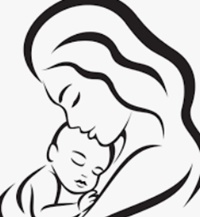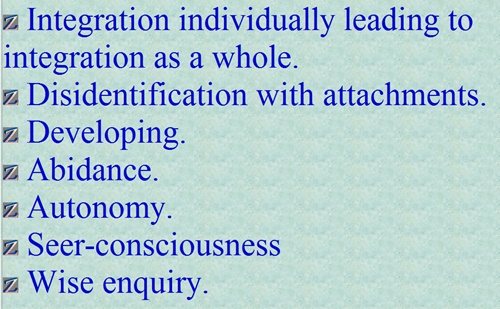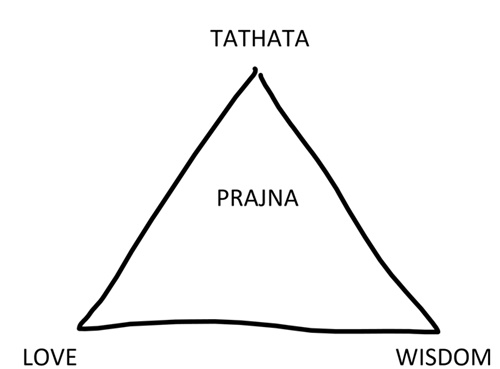One of the purposes of this z-quest into a possible secular path was to develop a path story, as worked out in the last chapter with amendments the Seeker Story has proven sufficient. But there is an additional stage in the seeker story that needs to be added – or rather developed. Engaging the MAWP is not sufficient in dealing with patriarchy we need to develop an approach that moves towards the feminine - maybe what some refer to as the divine feminine?
Immediately such an approach is proposed, in some quarters, especially those with power in the patriarchy, there is a male backlash. Love understands this backlash and as we cultivate love we begin to include these men the patriarchy has dumped on. But first we must establish this love, and in Real Love we start to get near our love when we begin with real true and spiritual love here:-

With the help of Nicola Amadora zandtao wants to take love as represented by this image of mother love further. Here, Nicola gives a meditation for loving the Divine Mother, the source of the mother-baby love depicted in the image. In other words Nicola is reconnecting us with the source that our first feeling of love gave us – first feeling of love discussed in Real Love. We reconnect with source – the Divine Mother, that is how we return to love – again discussed in Real Love.
Nicola addresses this meditation to women so is there appropriation? This has not been discussed with Nicola so maybe so. This meditation is part of Nicola’s approach of the deep feminine way yet zandtao is talking about this for men – all seekers? Prajna is love-wisdom, does it go beyond difference there? But within difference there is yin-yang:-

In this situation zandtao is interpreting this symbol as meaning masculine and feminine as a totality. But within the masculine there is feminine and vice versa. To zandtao this symbolises spiritually a feminine way for men in the patriarchy, this feminine is not just for women.
In patriarchy it is primarily men who have exploited the conditioning so men must begin to redress their own balance. It is to redress this imbalance in men that zandtao is encouraging the love of the Divine Mother although for all aspects of seeking it is beneficial; the Seeker Story has been amended accordingly.
Through reconnecting with the Divine Mother we reconnect with love as the stream of consciousness. We live and abide in love – in the stream of consciousness. Yet within the stream of consciousness there is conditioning and we need to go beyond our conditioning so we go beyond within the stream of consciousness – transcendent immanence. This beyond is not a separation, yet the transcendence of spiritual bypassing is separation. When we reconnect with the Divine Mother there is prajna – love-wisdom - that sees the truth. But this seeing is within the stream of consciousness, and beyond conditioning lives and abides in love. Through reconnection with Divine Mother all seekers abide in love, the Divine Mother can awaken prajna that develops deep seeing.
When Stephen looks at the secular path he does not note patriarchy, his concern appears to be focussed on institutional teachings - although our institutions are compromised by the patriarchy. Through good practice, such as a practice that would include zandtao’s 7 core components, there is the development of autonomy. This autonomy is independent of the teachers and institutions, but it needs also to be independent of the prevailing patriarchy. The seeker uses the seeker story to understand the impact of patriarchy on their upbringing and daily life, and with that recognition develops the need for balance through what could be seen as including a "feminine way for men". For women, teachers such as Nicola can help them go further; as a male advisor zandtao cannot have experience of the feminine (black yinyang dot only), what the true feminine is can only be partially understood through listening.
Within institutional learning there will be the institution’s version of the practice. Stephen was proposing the 4 Noble Truths as some from of secular practice – although zandtao is unsure as to secular for who. Zandtao came up with the 7 core components of practice:-

Of themselves they are not a practice, an institution or teacher would give such a practice. Zandtao recommends that seekers examine their institutional practice in light of these core components to see if there is a lacking. With cults there appears to be a practice of disidentification; but instead of there being autonomous personal integration as well as integration with the whole, there appears only to develop an identification with the cult leader. Any such identification with a guru or cult leader is dangerous and can lead to the seeker being vulnerable if that leader or teacher does not have integrity. For exposed cults that lack of integrity is increasingly being shown as evident primarily through sexual exploitation. This shows the  so prevalent in our society, in general society does not understand the spiritual lack at the basis of cults and their followers. so prevalent in our society, in general society does not understand the spiritual lack at the basis of cults and their followers.
Our religious institutions live within patriarchy, and as part of the institutions being accepted they have compromised with patriarchy. Should institutions compromise with patriarchy? This is legitimate questioning but it is not for zandtao to answer. As with individual seekers institutions need to examine what that compromise means. For individual seekers whose path has taken them through these institutions their seeker story needs to include their upbringing and how the institution’s compromise with patriarchy has affected them. There will be a need to promote the feminine (rebalance) – to develop prajna so that the seeker has the love-wisdom to see the truth, and zandtao is advising the seeker to begin doing this through reconnection with the Divine Mother. From this immanent reconnection there will grow the need for engagement that might have been lost in the bypassing of unbalanced transcendence; engagement is a duty of nature but that engagement is at the discernment of the seeker – it need not be 24/7 placard-waving. When the seeker reconnects with love it takes equanimity for such seekers not to rage against the patriarchy whose very existence diminishes love. Live with the feelings of love – don’t repress them, it is a consequence of deep love to be motivated by these feelings; zandtao found the Divine Mother’s love assuaging any rage through equanimity – helping prevent attachment.
For zandtao this z-quest has exposed the need for mindful dedication. Do we choose ego or sunnata? Our minds cannot choose sunnata yet through good dhamma practice we can reconnect with the Dhamma – touch sunnata.
Now, look at part 3 of the Bo tree ("Heart-wood from the Bo Tree" by Buddhadasa Bhikkhu), the first two parts had been looked at earlier - App E. Zandtao looked at this briefly but there was disruption. After the disruption there was a development of Mother-Love. Nicola had taken zandtao to mother-love – the love of the earth mother – the Divine Goddess (as discussed above). But today the visualisation wasn’t the same. He lay there (not sitting) and extended into the earth but not the solid earth but earth around him. He went deeper into the earth but it was not solid earth, it was earth presence. Returning to the visualisation he had no image – he doesn’t always have images but this visual imaging was less not more. Abandoning the visualising he became part of earth consciousness that was love. He extended into the love. Then gradually the love extended to his whole body, and this love was gaia-consciousness. It felt right (for the time). His feminine way was to gaia-consciousness (for now). He notes that there is a feeling that Nicola can take women further but it is not for zandtao to go there – or even try to go there. His prajna is gaia-consciousness – the love-wisdom that sees truth, the trinity:-

The disturbance that has been discussed before as arising when crossing the threshold of autonomy has its place here because the disturbance is the ego holding to the institution in Buddhism; autonomy has taken zandtao beyond institution. The institution has given zandtao his Dhamma practice, and in the institution there is far more wisdom than zandtao is aware of. But the institution can be a trap, it can contain ego, it can defintiely hold autonomy back. Zandtao’s habit of Buddhadasa by looking at the 3rd part of Bo tree wasn’t applicable here, and disturbance pushed away that 3rd part for a more appropriate time. For now the time is gaia-consciousness rebalancing the spiritual masculine bias, and he must watch for the bias - the male ego in spirituality. This will be hard because there is dominant male conditioning and not sufficient dedication on zandtao's part; to relax after writing he is now going to watch football!
His meditation journey the next day was similar taking him towards gaia-consciousness but it stopped with Gaia’s mother-love that was sunnata. Then from the 3rd part of Bo Tree (Heartwood of the Bo Tree) came remainderless extinction. Why isn’t remainderless extinction death? Why when I is removed from I and mine from the 5 khandhas is there not death? If there isn't death there is no self, what does that mean?
Zandtao has been listening to Tina Rasmussen at Batgap, it is freaking zandtao out the pace of these women (Nicola and Tina). Tina and Rick were talking of awakening and how people who are “awakened” have different characters or personalities. Tina discusses embodiment of awakening as being taking meditation off the cushion into daily life; for zandtao she is talking of the Dhamma comrade - sampajanna. When zandtao uses embodiment of awakening, it is concerned with the way awakening happens in daily life; Tina connected embodiment and sampajanna for zandtao.
If awakening is also remainderless extinction, is 100%-awakening also death? Or is 100%-awakening complete autonomy? Can there be complete autonomy? Let me give an ad-hoc temporary working definition of autonomy:- it is that part of sunnata that has been touched by the seeker, it is that part of the Dhamma that has been reconnected with, it is that part of consciousness that the seeker evolves. Autonomy takes form through the 5 khandhas so in a sense there is autonomy’s attachment. Because of anatta zandtao has always avoided Self, the capitalised self, because it sounds like ego – can we be sure that Self is not an ego trickster? Yet what if this Self is seen as autonomy - Michael Beckwith describes it as authentic self? What if the autonomy arising from the touching of sunnata is called Self - the authentic self? And this Self has the sampajanna that is the embodiment of awakening? Zandtao will continue to avoid the use of Self but if he comes across it he will see it as the autonomy arising from the touching of sunnata. Following Tina’s direction embodiment is for the autonomy of awakening - sampajanna, and attachment is for the ego of conditioning.
Except for fully-awakened individuals of which zandtao has no knowledge, in each individual there is a balance of autonomy and ego, awakened and unawakened, unconditioned and conditioned. And this is reflected in embodiment and attachment to the 5 khandhas – removing the I and mine from the 5 khandhas leaves only autonomy. We discover this autonomy through Dhamma practice to build awakening, and this autonomy is reflected as embodiment in the 5 khandhas.
This has implications for releasing egos. Zandtao recognises that egos arise through paticcasamuppada but zandtao has not really used paticcasamuppada for removing egos. He has released egos as part of his Dhamma practice in step 12 where he lets go of kilesa, upadanas and attachment to khandhas. This is not a conscious process but a state of mind – letting go of kilesa, upadanas and attachments. From Bo Tree parts 1 and 2 the choice is between ego and sunnata, but the I does not have the capability of choosing sunnata – that is a contradiction. The nearest we can get to choosing sunnata is through Dhamma practice, and in our Dhamma practice autonomy arises building awakening; perhaps now it is better to use the term Prajna practice as zandtao has crossed the threshold of autonomy – the threshold that is not attached to institution. So Prajna practice touches sunnata, reconnects with Dhamma, and recognises autonomy for building awakening. With Prajna practice zandtao can feel attachments, and as he builds the Prajna practice there is no room for attachments; they don’t belong and are released. Is this feeling a legitimate practice for releasing egos? Is this teachable? Is it acceptable?
Rather than the Dharma Dan drilling down on phassa (paticcasamuppada) or Buddhadasa’s removal of ignorance, can we remove ego through the presence that arises from Prajna practice? Is it accurate to say that Prajna practice expels ego? This is frightening and requires a huge bite of humility and mindfulness as he has not seen it discussed before.

This feeling can only be ratified by practice ie by zandtao's seeking or by other seekers? Develop your Prajna practice, feel for attachments and let them go. If it works zandtao will continue but with circumspection and humility. Zandtao doesn’t know but he does feel that developing Prajna practice can release attachments and build the embodiment of autonomy.
Working with Stephen has led to a clarity, a clarity that 2 months ago he would not have been able to accept; zandtao has moved beyond Buddhism – not beyond the teachings of Buddhist teachers necessarily but beyond the institution of Buddhism.
It is worth reflecting on personal history to understand the importance of this aspect of the threshold of autonomy. For many years after upheaval bill wandered around the bookshops and occasional talks of spiritual eclecticism, the year of theosophy being the only time where there was any form of intense learning. This year was also marked by another important characteristic of bill's early adult life, it was free from alcohol addiction. For the times when bill’s learning could have been most intense, perhaps a time when bill could have developed into an influential teacher as zandtao, bill’s ego chose the booze. His upheaval was fortunate - it was not worked for; so when there was a possibility for development into being a spiritual teacher bill’s ill-discipline chose alcohol.
Thirty-odd years later when bill retired early to dedicate himself more to spirituality, he focussed on Buddhism. Not only that but he focussed on Theravada Buddhism because he converted in Thailand at Wat Phra Keau, 7 years earlier. With the help of Harnham prior to retirement, his focus continued on Theravada ending the eclecticism that had previously not led him far. By the time he retired he only saw Theravada, mainly because of Harnham, with the Forest Sangha tradition. At some point fairly early on in his retirement he chose Buddhadasa, Buddhadasa became bill’s spiritual teacher leading to zandtaomed’s meditation method.
The threshold of autonomy has also developed with a different description – the threshold of institutionalism. Since the mid-life review in the mid-late 90’s Buddhism has been central to his understanding and development - even though he is aware that his developments across the threshold are not mainstream Buddhism. In choosing Buddhadasa he has also moved away from the mainstream even though in Thailand Buddhadasa is considered by many Thais as mainstream.
But Buddhadasa talks of no religion, and zandtao feels that way now; zandtao asks not to be considered a Buddhist because he does not want the identity of that institution. At the same time he will try to move his mind away from any institutional restrictions, it is only his autonomy that he holds true to now. There are many Buddhist teachers that zandtao will continue to learn from but his approach to learning will now differ. When he first met Buddhism he took the teachings as a guide, then slowly his learning was directed by his inner guide even though he would often fall back to Buddhadasa. Now his inner guide will fall back on his own autonomy.
This was inevitable given that he crossed the threshold of autonomy but it has taken time to understand the full impact of that crossing. Stephen started with a theory that there was a secular Buddhism based on the 4 Noble Truths. Exploring that zandtao arrived at the 7 core components of a secular practice:-

He examined the seeker story in terms of patriarchy and awakening, and then developed it to include a “feminine way” to counter the bias of patriarchal conditioning. But his autonomy takes him forward now. He does not want to be held back by dogma such as reincarnation. His practice as Prajna practice promotes his autonomy.
Where will his autonomy take him?
Where will this autonomy take him towards the feminine? How will zandtao do that? In this chapter zandtao has begun by connecting with the Divine Mother through Nicola's meditation, but this can only be the beginning.
Next/Contents/Previous
|


